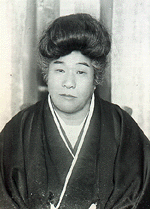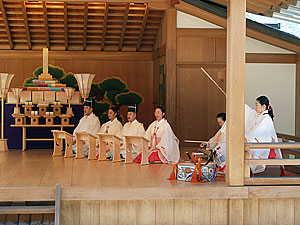Oomoto's Co-Founder, Onisaburo Deguchi

Birth and Passing
Onisaburo Deguchi was born with the name Kisaburo Ueda in 1871, in Kyoto Prefecture's Kameoka City. He passed away on January 19, 1948, at the age of seventy-eight.
Childhood and Youth
From a young age Onisaburo was recognized as a prodigy, and he displayed extraordinary psychic abilities. Born into a small farming family, he dropped out of elementary school. He was able to continue his studies on the side while he farmed, made lemon soda, raised cattle, and did other odd jobs, but certainly tasted his share of hardship.
Mystical Training on Mount Takakuma
In the second lunar month of 1898, Onisaburo spent a week undergoing spiritual training on the sacred mountain Takakuma, in his hometown of Kameoka. During that time he profoundly studied many mysteries of the spiritual world, realizing a high degree of skill in clairvoyance, clairaudience, telepathy, prophecy, mind-reading, and others. At this point he became aware of his great mission towards the salvation of the world.
Encounter with the Foundress
Receiving the divine instruction to "Go towards the northwest," Onisaburo met Nao Deguchi, Oomoto's Foundress, in Ayabe City, northwest of Kameoka. From this time, in 1898, he joined forces with the Foundress to promote Oomoto's divine work. Before long, he married Sumiko, Nao's youngest daughter who later became the Second Spiritual Leader. Later as Co-Founder he began proclaiming the teachings of Oomoto along with the Foundress.
Dictation of "Tales from the Spiritual World"
In 1921, to relieve the crises facing humanity, to right the confusion in people's minds, to make proper use of religion and science, and to aid in the reconstruction of human beings' souls, Onisaburo Deguchi dictated "Tales from the Spiritual World." The 81-volume set is a guide for humanity to pass into eternity.
"Tales from the Spiritual World" elucidates the true meaning of the Foundress' written oracles. In addition, it relates the history of the spiritual world (beginning with the creation of heaven and earth), and presents a design for the construction of paradise on earth.
All Religions spring from the Same Source: Interfaith Activities
In 1923 Onisaburo adopted into Oomoto the international language Esperanto. In 1925, the inauguration of the World Religious Federation took place under Onisaburo's initiative. Oomoto began to lead the way for the union of humanity. By establishing the Universal Love and Brotherhood Association (ULBA), Oomoto contributed to helping humankind go beyond the tangible and intangible barriers between different ethnic groups, races, religions, etc.. It joined forces with new spiritual movements all over the world, including Cao Dai in Viet Nam, Weisse Fahne (White Flag) in Germany, the Universal White Brotherhood in Bulgaria, Tao Yuan in China etc. These activities laid the cornerstone for Oomoto's international interfaith activities, continuing to this day.
The Arts and the Scintillating Tea Bowls
Onisaburo emphasized that "Art is the mother of religion; art gives birth to religion." He further explained: "The God who created the great infinite cosmos must be the Great Artist. The driving force to create heaven and earth is the germination of the Great Artist's seed."
Given that art and religion are one and the same, it naturally follows that one must love nature for its intimate connection with the arts-as source of materials, subject matter, and inspiration. Onisaburo left an expansive body of artistic works in many disciplines, including literature, painting, calligraphy, ceramic pottery, poetry, songs and others.
Amongst those works, many people have been surprised by the 3000 handmade tea bowls, into the creation of which Onisaburo poured his energy later in life. Glazed with vivid colors reminiscent of French impressionist paintings, they were given the name "Scintillating Bowls" in 1949. Later these tea bowls became the central works for an internationally acclaimed art exhibit that toured thirteen cities in six European and North American countries. The exibit was entitled "The Art of Onisaburo Deguchi and His School."
Mount Takakuma is located to the west of Kameoka City's Sogabe town. From downtown Kameoka, it is about 20 minutes by car, followed by a 30 minute climb on foot. Those wishing to make a pilgrimage to the shrine there are encouraged to contact
Oomoto headquarters at
webmaster@oomoto.or.jp
(or phone: +81-771-22-5561).
New Contents Thu, May 20, 2010
- Oomoto participates in Sant’Egidio conference : Dialogue among religions and cultures : On divided island nation of Cyprus By Bill Roberts
- Photo Album : Portraits of three branches: Shoko, Tanegashima and Aomori By Bill Roberts
- Oomoto FAQ
- A Letter from Oomoto : Of mountains and myths By Bill Roberts
- Polyglot poem festival The Utamasturi is going international — what’s next? By Bill Roberts
- Ethics education program captures the spirit of Bankyo Dokon By Bill Roberts
- A Letter from Oomoto : A year’s worth of adventure in a summer of branch visits By Bill Roberts
- In Kumamoto, it’s all about water – and fire By Bill Roberts
- A speech by Nevada Taylor at the Kii Branch in Wakayama Prefecture on April 13, 2008.:An Encounter With Oomoto Through Aikido
- Utamatsuri, Poem Festival, in Tokyo(on April 17, 2008)
- A speech by Neil Ryan Walsh at the Kobe branch on Mar. 9th, 2008.:Planting the Seeds of the Soul
- Meeting with the Fifth Spiritual Leader of Oomoto, Madame Kurenai Deguchi by Neil Ryan Walsh
- A speech by Neil Ryan Walsh at the Nagoya branch on Feb. 17th, 2008.:The Japanese Arts beyond National Boundaries
- To the Oomoto branch in Nagoya: City of Eel and Toyota by Neil Ryan Walsh
- A Speech by Nissim Ben Shitrit, Ambassador of Israel on the occasion of the Oomoto Setsubun Grand Festival in Ayabe February 3rd, 2008 : Japan and Israel : Two Lands Balancing the Needs of Traditional Culture and Modern Life. r
- A permanent memorial to Onisaburo (A Speech at the Autumn Grand Festival , November 6, 2007 : )By James Parks Morton, Founder and Chair, Emeritus of The Interfaith Center of New York
- Israel, Palestine and the Power of Poetry(Oomoto believes small efforts can have lasting ripple effects on people and peace)By Bill Roberts
- “Something Great”(This genetics pioneer, a friend of Oomoto, offers a clue to the mystery of life)By Bill Roberts
- Kamishima Cleanup (Harima branch members regularly visit this sacred island to keep the shrine tidy)By Bill Roberts
- Kyotaro Deguchi was one of six recipients of the 2007 James Parks Morton Interfaith Award
What is Oomoto?
- What is Oomoto?
- Spirtual Centers
- Founders and Spiritual Leaders
- History
- Organization and activities
- Teachings and scriptures
- Art Works of Founders and Leaders
Opinions[Archive]
- Statement of regret for the outbreak of war against Iraq (March 20,2003)
- Jinrui Aizenkai dispatched the "Urgent Appeal for a World (Global) Crisis" on March 14.
Grappling with Bioethics[Archive]
- Oomoto’s support for abolishing the death penalty (12, June 2003)
- The Oomoto Foundation protests any birth of a human clone baby. (5, January 2003)
- OOMOTO'S VIEW REGARDING JAPAN’S PERMITION TO THE RESERCH OF HUMAN EMBRYONIC STEM CELLS (ES cells)(12, June 2000)
Vistor’s Review[Archive]
- A speech by Bill Roberts at the Oomoto branch in Hiroshima after its monthly service on March 18, 2007:Encounters with war and peace
- How Bankyo Dokon changed one life by Linda Macphee
- A speech by Bill Roberts at the Hokuriku (Kanazawa) branch on Dec. 3, 2006:Ritual and myth -an encounter with ‘divine madness’
- A speech by Bill Roberts at the Himeji Cultural Center on Feb. 25, 2007:Mesmerized by the Japanese Arts
- A speech by Bill Roberts at the Kobe branch on Feb. 11th, 2007.:There are just human tears and human joy
- A Speech on the occasion of the Oomoto Setsubun Grand Festival in Ayabe February 3rd, 2007 : Egypt's role in Middle East peace
- Keynote Speech for the 28th World Federation Japanese Religionists Conference for World Peace in Tokyo (at Kokugakuin University, Novermber 29, 2006):Vision for Peace in the Middle East By Dr. Munther S. Dajani, Professor Dean, Faculty of Arts, Al Quds University, Jerusalem
- A speech to the Kyoto branch:Spiritual adventures in researching Oomoto leaders
- A Speech at The Oomoto Foundation on Monday, November 6, 2006 : Jordan's role in Middle East By Samir Nouri, Ambassador of the Hashemite Kingdom of Jordan
- A letter from Oomoto:The Young People of Tottori
- A speech by Bill Roberts on the occasion of the dedication ceremony for the new shrine of Tottori Branch By Bill Roberts Oct. 8, 2006
- A speech by Bill Roberts at the Oomoto branch in Hiroshima after its monthly service on March 18, 2007:Encounters with war and peace
- How Bankyo Dokon changed one life by Linda Macphee
- A speech at Setsubun : A Portrait of Oomoto By Bill Roberts Feb. 3, 2006
- New Publication ! By Bill Roberts Feb. 3, 2006 A Portrait of Oomoto
you can read this book in html => http://www.jinruiaizenkai.jp/English/en-kolumno/en-bill/en-sugao/billbook1en.html
E-mail below to order brobert1@ix.netcom.com
Current Topics
- Prayer Offering and World Religious Forum II
- Living the art of dialogue
- Kyotaro Deguchi was one of six recipients of the 2007 James Parks Morton Interfaith Award
Books
Online Books
- Divine Signposts by Onisaburo DEGUCHI
- The Creation of Meaning by Hidemaru Deguchi
- Bankyo Dokon(Seventy years of Inter-Religious Activity at Oomoto)
- Nao Deguchi — A Biography of the Foundress of Oomoto
- The Great Onisaburo Deguchi published by Aiki News
- Bankyo Dokon Seventy Years of Inter-Religious Activity at Oomoto
- Insearch of Meaning
- Nao Deguchi A Biography of the Foundress of Oomoto
- A Portrait of Oomoto By Bill Roberts
Oomoto international Archive
- The History of Oomoto (Jan.– Mar. 1980 — Apr.– Jun. 1982)
- The Ancestors; Friends or Foes? (Apr.– Jun. 1987)
- Tsukinamisai; The Sabbath of Shinto (Jan.– Jun. 1983)
- The Poem Festival at Oomoto; An Ancient Rite Lives Again (Oct.– Dec. 1981)
- Purification of the Universe ; Oomoto's Setsubun Festival (Apr.– Jun. 1981)
Links
Flowers at Ten'on-kyo & Baisho-en (photographs)
Contact
All rights reserved : the Oomoto Foundation Produced by the Netinformational Commission
Since : Mar. 7.1998 Last Update : Thu, May 20, 2010
E-mail : webmaster@oomoto.or.jp
Top Page Nihongo Esperanto Português Roomazi



